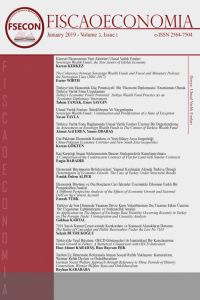Öz
Kaynakça
- Altunöz, U. (2014). “Cari Açık Sorununun Temel Nedenleri ve Sürdürülebilirliği: Türkiye Örneği”. İstanbul Gelişim Üniversitesi Sosyal Bilimler Dergisi, 1 (2), 115-132.
- Brissimis S. N., Hondroyiannis G., Papazoglou C., Tsaveas N. T., Vasardani M. A., (2010). “Current Account Determınants And External Sustaınabılıty In Perıods Of Structural Change”. Europan Central Bank. 1-36.
- Burbidge J., Harrison, A. (1985). “An Historical Decomposition Of The Great Depression To Determine The Role Of Money”. Journal of Monetary Economics. Jul 1;16(1):45-54.
- Edwards, S. (2001). “Does the Current Account Matter?”. This PDF is a selection from a published volume from the National Bureau of Economic Research. (8275), 21-66.Efron B. (1982). The jackknife, the bootstrap and other resampling plans. Society for industrial and applied mathematics.
- Ferretti, M., Maria, G., Razin, A. (1996). “Current Account Sustainability”. Princeton Studies in International Finance 81, 3-67
- Fountas, S. ve Wu, J. (1999). Are The U.S. Current Account Deficits Really Sustainable? International Economic Journal, Vol. 13, No. 3, 51-58.
- Freund, C ve Warnock , F. (2005), “Current Account Deficits In Industrial Countries: The Bigger They are, The Harder They Fall? , NBER Working Paper , No:118236.
- Karunaratne, N. D. (2010), “The Sustainability of Australia’s Current Account Deficits-A Reappraisal After the Global Financial Crisis”, Journal of Policy Modeling, 32, 81–97.
- Kim, B., Min, H., Hwang, Y., McDonald, J. (2009). “Are Asian Countries Current Accounts Sustainable? Deficits, Even When Associated with High Investment, Are Not Costless”. Journal of Policy Modeling, No. 31, 163-179.
- Lütkepohl H. (2005). New İntroduction to Multiple Time Series Analysis. Springer Science and Business Media, Dec 6.
- Takeuchi, F. (2010). “US External Debt Sustainability Revisited: Bayesian Analysis of Extended Markov Switching Unit Root Test”. Japan and the World Economy, 22, 98–106.
- Turan, Z., Barak, D., (2016). “Türkiye’de Cari İşlemler Açığının Sürdürülebilirliği”. İşletme ve İktisat Çalışma Dergisi, (4) 2, 70-80.
A Different Perspective Analysis of the Effects of Economic Growth and External Debt on the Current Account
Öz
One of the most important problems of Turkey's economy is to have continuous current account deficit. In order to ensure macroeconomic balances, the current account deficit should be sustainable. In this context, the effects of the economic growth, public and private sector external debt stocks’ on the sustainability of the current account deficit are handled with a different perspective. In this context, the historical decomposition method obtained from vector autoregression (VAR) model was used by using quarterly data between the periods of 1992Q1-2017Q3. In order to measure the effect of variables on current transactions, unlike other models, a positive shock is given to all variables in every period. As a result, the variables, that are discussed, they do not have a regenerative effect on the sustainability of the current account deficit. Until 2001, the negative effects of public sector debts on the sustainability of current transactions are observed. After 2001, it was estimated that the private sector's debts had a negative effect on the sustainability of current transactions andprivate sectors couldn’t pay their debts. This means that the private sector will have a strong share in a new economic crisis.
Anahtar Kelimeler
Kaynakça
- Altunöz, U. (2014). “Cari Açık Sorununun Temel Nedenleri ve Sürdürülebilirliği: Türkiye Örneği”. İstanbul Gelişim Üniversitesi Sosyal Bilimler Dergisi, 1 (2), 115-132.
- Brissimis S. N., Hondroyiannis G., Papazoglou C., Tsaveas N. T., Vasardani M. A., (2010). “Current Account Determınants And External Sustaınabılıty In Perıods Of Structural Change”. Europan Central Bank. 1-36.
- Burbidge J., Harrison, A. (1985). “An Historical Decomposition Of The Great Depression To Determine The Role Of Money”. Journal of Monetary Economics. Jul 1;16(1):45-54.
- Edwards, S. (2001). “Does the Current Account Matter?”. This PDF is a selection from a published volume from the National Bureau of Economic Research. (8275), 21-66.Efron B. (1982). The jackknife, the bootstrap and other resampling plans. Society for industrial and applied mathematics.
- Ferretti, M., Maria, G., Razin, A. (1996). “Current Account Sustainability”. Princeton Studies in International Finance 81, 3-67
- Fountas, S. ve Wu, J. (1999). Are The U.S. Current Account Deficits Really Sustainable? International Economic Journal, Vol. 13, No. 3, 51-58.
- Freund, C ve Warnock , F. (2005), “Current Account Deficits In Industrial Countries: The Bigger They are, The Harder They Fall? , NBER Working Paper , No:118236.
- Karunaratne, N. D. (2010), “The Sustainability of Australia’s Current Account Deficits-A Reappraisal After the Global Financial Crisis”, Journal of Policy Modeling, 32, 81–97.
- Kim, B., Min, H., Hwang, Y., McDonald, J. (2009). “Are Asian Countries Current Accounts Sustainable? Deficits, Even When Associated with High Investment, Are Not Costless”. Journal of Policy Modeling, No. 31, 163-179.
- Lütkepohl H. (2005). New İntroduction to Multiple Time Series Analysis. Springer Science and Business Media, Dec 6.
- Takeuchi, F. (2010). “US External Debt Sustainability Revisited: Bayesian Analysis of Extended Markov Switching Unit Root Test”. Japan and the World Economy, 22, 98–106.
- Turan, Z., Barak, D., (2016). “Türkiye’de Cari İşlemler Açığının Sürdürülebilirliği”. İşletme ve İktisat Çalışma Dergisi, (4) 2, 70-80.
Ayrıntılar
| Birincil Dil | İngilizce |
|---|---|
| Bölüm | Makaleler |
| Yazarlar | |
| Yayımlanma Tarihi | 31 Ocak 2019 |
| Yayımlandığı Sayı | Yıl 2019 Cilt: 3 Sayı: 1 |
Fiscaoeconomia is licensed under a Creative Commons Attribution-NonCommercial-ShareAlike 4.0 International License.


